Converting your camera for digital lab photography is simpler than you think. Start with proper lighting equipment—diffused LEDs or lightboxes—and secure mounting solutions like tripods or copy stands. Add specialized film holders for negatives and consider macro lenses for detail work. Optimize settings with low ISO, faster shutter speeds, and higher f-stops. Software like FilmLab can streamline your post-processing workflow. The right combination of affordable adapters and techniques will transform your existing camera into a professional lab tool.
Second-Level Headings for Blog Post
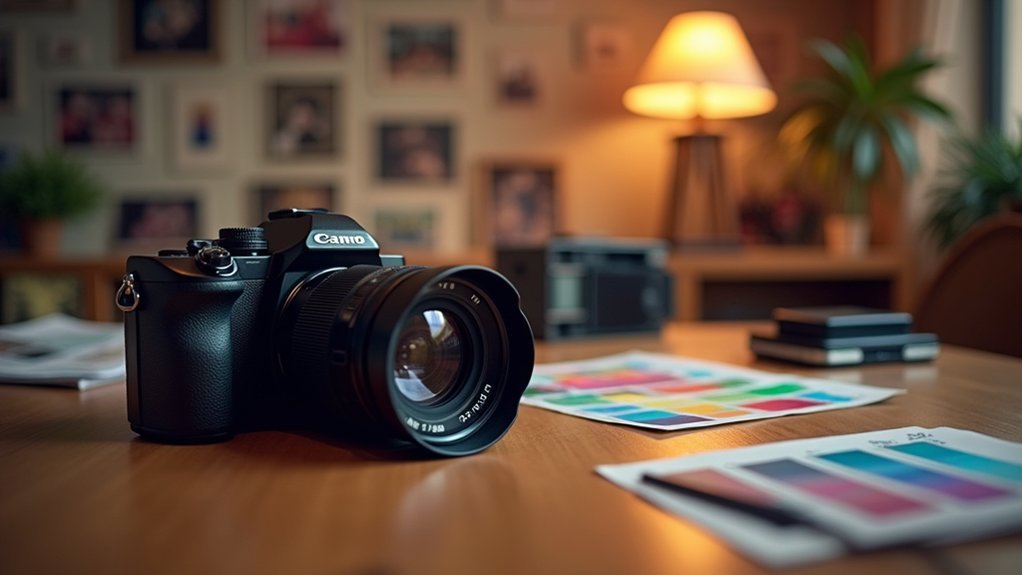
When planning your blog post about converting cameras for digital lab photography, you’ll need clear, organized sections to guide readers through the process.
Consider these essential headings to structure your content effectively:
Structure your content with essential headings to guide readers clearly through each step of the conversion process.
“Getting Started with FilmLab” might be a little intimidating for beginners, so break down the initial setup process.
“Compatible Camera Models” helps readers determine if their equipment works with the software.
“Step-by-Step Conversion Process” outlines what users would need to digitize their negatives.
Include “Cross-Platform Accessibility” to highlight FilmLab’s availability on multiple devices.
“Darkroom-Inspired Controls” showcases the authentic editing features.
Finally, add “Quick Scanning for Social Media” and “Creating Digital Proof Sheets” to demonstrate the practical applications that make FilmLab valuable for photographers who need a little bit of guidance in their digital workflow.
Essential Equipment for Converting Your Camera to Digital Lab Use
When setting up your digital lab photography system, you’ll need proper studio lighting that provides even illumination without harsh shadows or glare on your subjects.
Choose background materials that complement your subjects while minimizing distractions, with options ranging from seamless paper to specialized light-diffusing materials for negative scanning.
Your camera mounting options should prioritize stability and precision positioning, including tripods with macro rails, copy stands, or specialized film holders that maintain perfect alignment throughout the digitization process.
Studio Lighting Setup
Although amateur photographers often overlook lighting considerations, creating an ideal studio lighting setup forms the foundation of successful digital lab photography. You’ll need a neutral gray background to eliminate color casts and guarantee accurate reproduction when digitizing your negatives.
| Equipment | Purpose | Recommendation |
|---|---|---|
| LED Lights | Consistent illumination | Adjustable color temperature |
| Diffusers | Eliminate harsh shadows | Translucent panels or softboxes |
| Lightbox | Even backlighting | 5000K daylight balanced |
| Tripod | Image stability | Heavy-duty with adjustable height |
Opt for soft, diffused lighting to prevent harsh shadows on your film negatives. Position your LED lights at 45-degree angles to provide even coverage. You’ll find that a properly illuminated lightbox makes transparent film materials much easier to digitize while maintaining consistent color fidelity across your entire workflow.
Background Material Selection
Choosing the right background material represents one of the most critical decisions you’ll make when converting your camera for digital lab photography. A neutral gray background is essential for accurate color reproduction in your digitized images. This choice minimizes color cast and eliminates distractions, allowing your film negatives to be the sole focus.
When selecting your background, prioritize materials with non-reflective surfaces that won’t create unwanted highlights or glare. This is particularly important when you’re using a lightbox setup for backlit film scanning.
The background should complement your lighting arrangement, working with your diffused light sources to create consistent, even illumination across your subject. Remember that your background choice directly impacts the quality of detail your macro lens can capture, so investing in proper materials now will save you countless editing hours later.
Camera Mounting Options
With your background materials selected, secure mounting becomes your next priority for achieving professional-quality digitization. A tripod adapter provides essential stability and precise positioning control when photographing film negatives, eliminating hand-shake that could blur fine details.
For best results, consider a copy stand. This adjustable platform guarantees your camera remains perfectly perpendicular to your film, ensuring consistent focus across the entire negative.
Pair this with specialized film holders or masks that prevent light leaks and maintain proper negative positioning.
Your lens choice matters greatly. Macro lenses excel at capturing minute negative details, while longer focal lengths reduce distortion.
Remember to match your camera’s sensor resolution to your film format—higher resolution sensors will produce sharper, more detailed scans of your precious negatives.
Selecting the Right Digital Microscope Adapter for Your Camera Model
Before you can start capturing detailed microscopic images, you’ll need to find a digital microscope adapter that’s fully compatible with your camera model.
Check manufacturer specifications to guarantee proper fit and functionality with your specific camera.
Look for adapters with adjustable zoom and focus features, as these will give you greater control over image quality.
Prioritize adapters offering adjustable zoom and focus to maximize control over your microscopic image precision.
Higher-quality optics greatly improve clarity and detail in your microscopic photography, making the investment worthwhile.
Consider versatility in your selection—adapters that offer both eyepiece and direct camera mounting options provide flexibility for different photography scenarios.
Don’t overlook user reviews when making your decision; they’ll often reveal practical insights about durability and ease of use that specifications alone won’t tell you.
Troubleshooting Camera Adapter Compatibility Issues
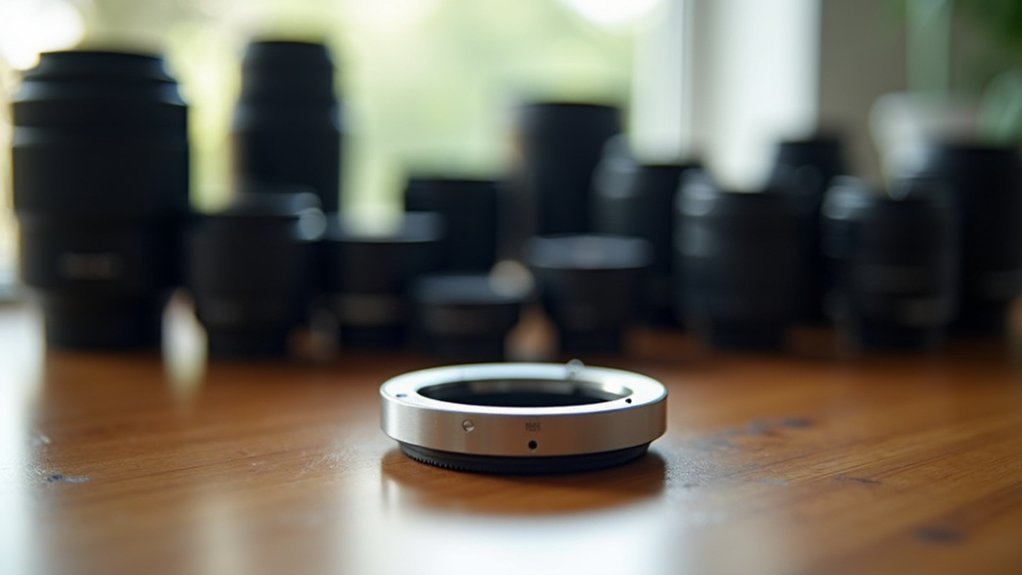
When you’re facing a connection port mismatch, you’ll need to identify whether your camera requires a T-mount, C-mount, or proprietary connection before purchasing an appropriate adapter.
Lens mount alignment problems often manifest as uneven focus or vignetting, which you can resolve by adjusting the adapter’s orientation or using spacer rings.
If you’ve confirmed both the correct port type and proper alignment but still encounter issues, check that your adapter’s thread pitch matches your camera’s specifications exactly.
Connection Port Mismatch
Although converting your camera for digital lab photography seems straightforward, connection port mismatches often frustrate even experienced photographers. When your adapter and camera won’t connect, the issue typically lies in incompatible ports.
First, identify the exact port types on both your camera and adapter. Common connections include USB, HDMI, and manufacturer-specific proprietary ports.
Don’t assume all USB ports are identical—they vary in version and shape. Check your camera’s manual or the manufacturer’s website to confirm the required connection type.
Using an incompatible adapter will result in signal loss or limited functionality. Remember that even with matching physical ports, outdated drivers can prevent proper communication.
Ascertain you’ve installed all necessary software updates for both devices to establish a reliable connection for your lab photography setup.
Lens Mount Alignment
Precision in lens mount alignment stands as the foundation of successful digital lab photography conversions. When your adapter isn’t perfectly aligned with your camera’s mount, you’ll experience frustrating focus issues and unwanted vignetting in your lab images.
Check these critical alignment factors:
- Verify your camera’s flange distance compatibility with your specific adapter model before attempting installation.
- Use a lens mount alignment jig when troubleshooting persistent focus problems—this tool quickly identifies and helps correct misalignment issues.
- Clean contact points regularly as even microscopic debris can cause misalignment.
If you’re still encountering sharpness discrepancies across your frame, test your setup with a calibration target. This will confirm whether alignment issues are causing the problem rather than other potential factors.
Optimizing Camera Settings for Microscope Photography
How effectively you configure your camera can make the difference between blurry specimens and crystal-clear scientific images.
Start by setting your ISO to a low value (100-200) to minimize noise and enhance clarity in your microscope photography.
Select a fast shutter speed of at least 1/100th second to eliminate motion blur, especially when working with living specimens.
Choose a higher f-stop (f/8 to f/16) to increase your depth of field, ensuring more of your specimen remains in focus.
Always use manual focus for precise control, as autofocus typically struggles with microscopic details.
Finally, mount your camera on a tripod or stable platform to prevent vibrations and maintain consistent framing throughout your imaging session.
These optimizations will dramatically improve your microscopic image quality.
Lighting Techniques for Professional Microscope Imaging

When it comes to microscope imaging, lighting makes the difference between amateur snapshots and publication-quality results.
You’ll need to master both light positioning and intensity control to capture specimen details effectively.
Combine ambient light with directed illumination sources like LED ring lights or fiber optics to eliminate shadows and reveal intricate structures.
For ideal results:
- Adjust light angle and intensity—use softer lighting to reduce glare and angled illumination to highlight surface textures
- Add polarizing filters to eliminate reflections and enhance color saturation, especially valuable for transparent specimens
- Maintain consistent lighting conditions across all imaging sessions to guarantee reproducible results for accurate comparison
These techniques will transform your microscope photography, allowing you to document specimens with the clarity and detail required for professional applications.
Post-Processing Software Options for Lab Photography
After capturing your images, the right post-processing software transforms raw laboratory photographs into publication-ready visuals. For lab professionals working with film negatives, FilmLab offers an exceptional solution across multiple platforms.
| Software Feature | Benefit | Platform |
|---|---|---|
| Raw File Support | Compatible with hundreds of camera models | macOS, Windows, iOS, Android |
| Custom Processing Engine | Authentic colors and tones similar to darkroom results | All platforms |
| Mobile Scanning | Quick scans and proof sheet creation | iOS, Android |
FilmLab’s intuitive interface streamlines the digitization workflow without requiring additional programs. You’ll appreciate how it efficiently converts digital captures into high-quality images, making it valuable for both amateur microscopists and professional researchers who need to digitize their film collections efficiently and share results quickly.
Budget-Friendly Camera Conversion Solutions
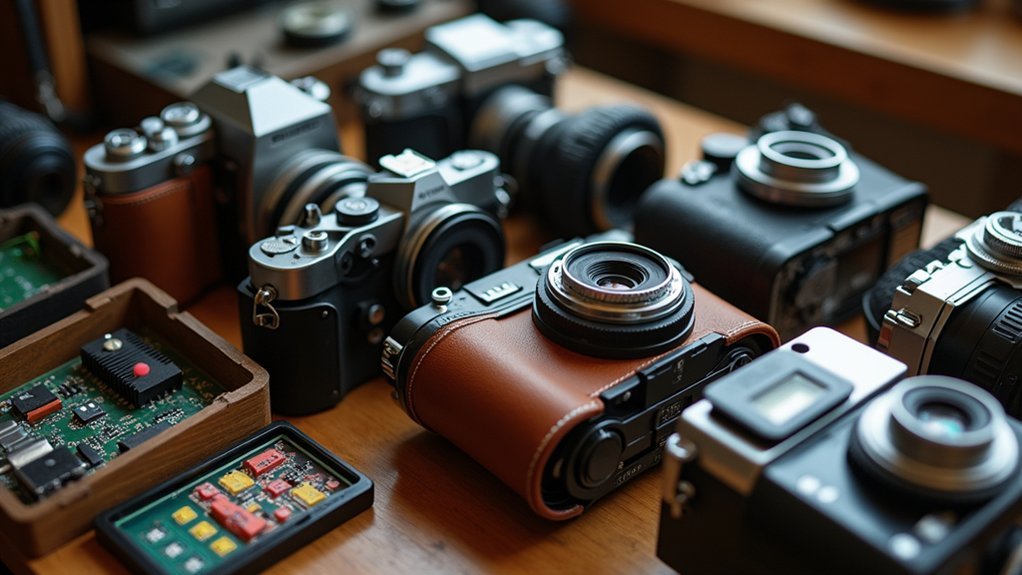
You don’t need expensive equipment to transform your existing camera into a film digitization tool.
Affordable DSLR adaptations, smartphone conversion accessories, and simple DIY lightbox setups can all provide excellent results without breaking the bank.
Whether you’re repurposing an old camera or maximizing your smartphone’s capabilities, these budget-friendly solutions make digital lab photography accessible to photographers at any level.
Affordable DSLR Adaptation Methods
While professional digitization equipment often comes with steep price tags, transforming your existing DSLR into a powerful lab photography tool doesn’t have to break the bank.
You can leverage inexpensive adapters and mounts to achieve compatibility with various film formats, making digitization accessible for any budget.
Consider these cost-effective approaches:
- Use your camera’s live view feature with proper lighting to capture images directly from negatives, eliminating the need for expensive scanners.
- Try DIY modifications like carefully removing internal IR filters or using specialized third-party software to enhance your camera’s digitization capabilities.
- Join online photography communities where enthusiasts share tried-and-tested adaptation techniques and troubleshooting tips.
These methods allow you to repurpose equipment you already own while achieving professional-quality results for your film digitization projects.
Smartphone Conversion Equipment
Three revolutionary smartphone accessories have transformed mobile devices into powerful tools for digital lab photography. Clip-on lenses enhance your phone’s optical capabilities, allowing for macro photography and wider angles without sacrificing image quality.
External lighting solutions provide consistent illumination critical for capturing film negatives with proper exposure.
To digitize film, apps like FilmLab convert negatives directly through your smartphone camera, eliminating expensive scanner hardware.
For stability—essential when capturing high-resolution images—invest in a smartphone-compatible tripod or gimbal.
These budget-friendly solutions make digital lab photography accessible to amateurs and professionals alike. You’ll benefit from your smartphone’s advanced sensors and processing power while spending a fraction of what traditional equipment costs.
The combination of hardware accessories and specialized apps creates a complete digitization studio that fits in your pocket.
DIY Lightbox Solutions
The humble cardboard box serves as the foundation for an effective DIY lightbox, transforming any camera into a digital lab photography tool without breaking the bank. By lining the interior with white poster board, you’ll create a neutral background that guarantees accurate color reproduction while minimizing distractions in your digital captures.
For ideal results, consider these enhancements:
- Install affordable LED strip lights around the interior to provide bright, even illumination.
- Add a white shower curtain or fabric as a diffusion layer to soften light and reduce harsh shadows.
- Position your film negatives or subjects centrally to take advantage of the evenly distributed light.
This simple setup considerably reduces shadows and reflections, resulting in clearer, more professional-looking images regardless of which camera you’re using for your photography projects.
Advanced Techniques for High-Magnification Microscopy
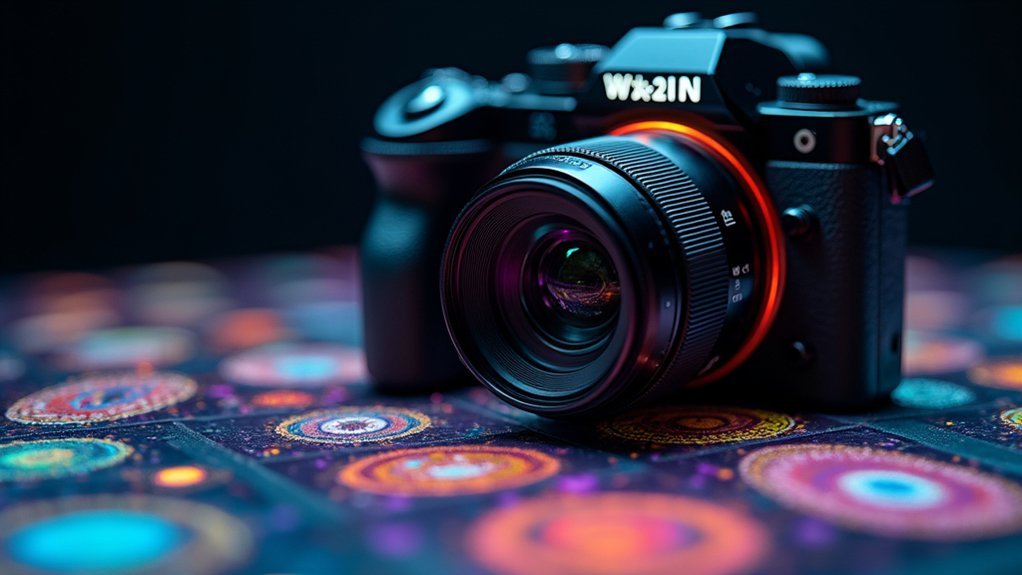
When diving into high-magnification microscopy, you’ll need to master several specialized techniques to achieve professional-quality results.
Start by investing in quality optics—achromatic or apochromatic objectives minimize chromatic aberration and dramatically improve image clarity at higher magnifications.
Pair your setup with a high-resolution camera sensor to capture minute structural details that would otherwise be lost.
To overcome limited depth of field, implement focus stacking by combining multiple images taken at different focal planes.
Don’t underestimate the importance of lighting—experiment with brightfield, darkfield, or fluorescence techniques to reveal different specimen features.
If you’re on a budget, try macro extension tubes or bellows to increase your lens’s effective focal length, boosting magnification without purchasing expensive microscope equipment.
Camera Mounting Systems for Stable Microscope Images
Securing your camera properly to your microscope represents the foundation of successful digital lab photography. Without a stable mounting system, vibrations and movement will compromise your image quality, no matter how sophisticated your equipment.
Choose from various mounting options to enhance your workflow:
- Universal brackets provide flexibility for different camera models, allowing you to switch equipment without purchasing new mounts.
- Dedicated microscope camera adapters guarantee perfect alignment and compatibility with specific microscope designs.
- Adjustable mounts let you fine-tune camera position for ideal composition and lighting conditions.
A quality mounting system not only protects your equipment but greatly reduces setup time.
You’ll spend less time aligning and focusing, and more time capturing the high-quality microscopic images your research demands.
Frequently Asked Questions
What Is the Free App That Converts Negatives to Digital Photos?
FilmLab is the free app you’re looking for. It’s available on iOS and Android, allowing you to convert negatives to digital photos with features like preview, proof sheets, and quick scans.
What Digital Camera Takes Pictures Like a Film Camera?
You’ll find Fujifilm X-series, Sony Alpha, and Leica M cameras excellent for film-like photos. They offer film simulation modes, manual controls, and exceptional image quality that closely mimics the aesthetic of traditional film photography.
How to Level a Camera for Film Scanning?
You’ll need a sturdy tripod with adjustable legs. Use a bubble level or smartphone app to guarantee your camera’s perfectly horizontal. Secure the film flat in its holder and position your camera perpendicular to the film plane.
How to Convert Photo Film to Digital?
To convert photo film to digital, you’ll need a digital camera, proper lighting, and software like FilmLab. Place negatives on a light source, capture them with your camera, then process using the software.
In Summary
You’ve now got everything you need to transform your camera into a powerful lab photography tool. Don’t hesitate to experiment with different adapters and settings to find what works best for your specific needs. With a bit of practice, you’ll be capturing professional-quality microscope images in no time. Remember, the perfect setup balances your budget, camera compatibility, and image quality requirements.

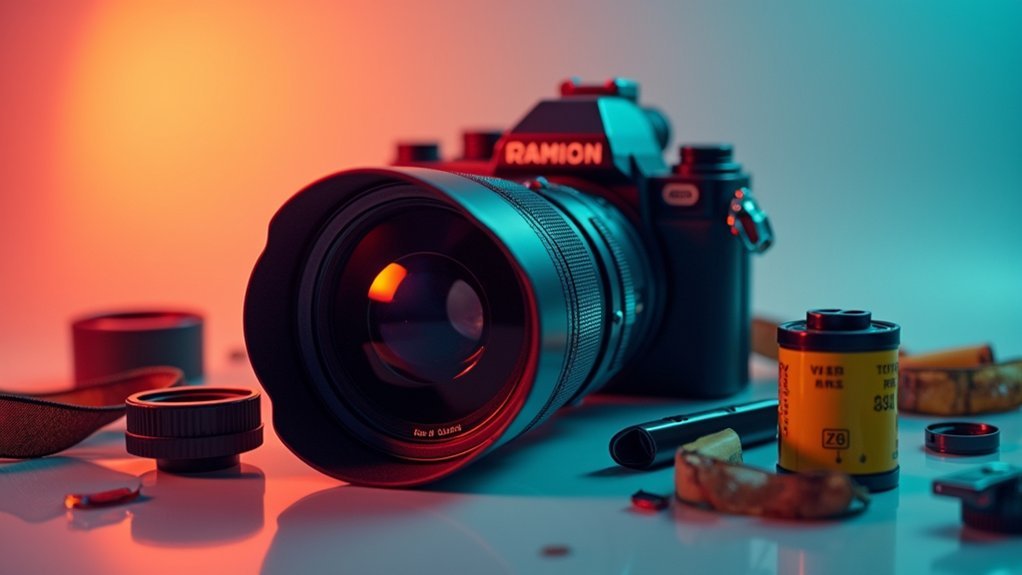



Leave a Reply